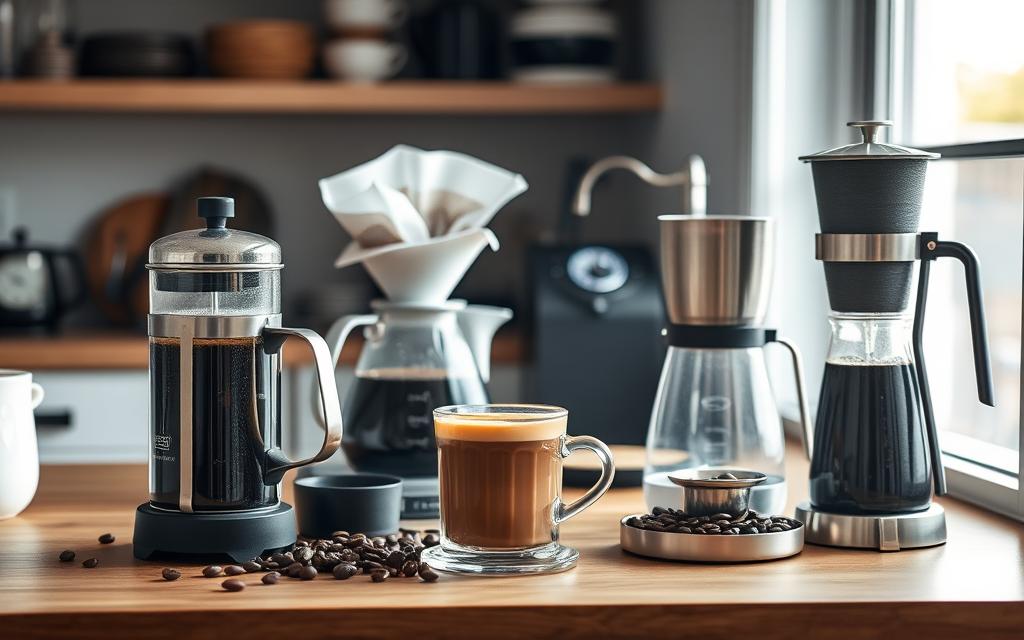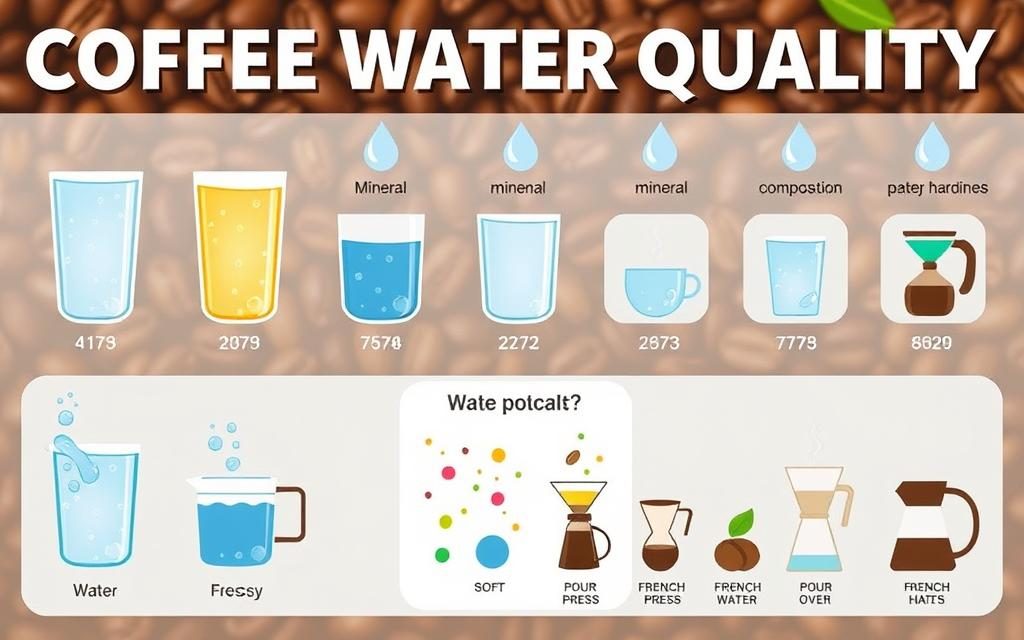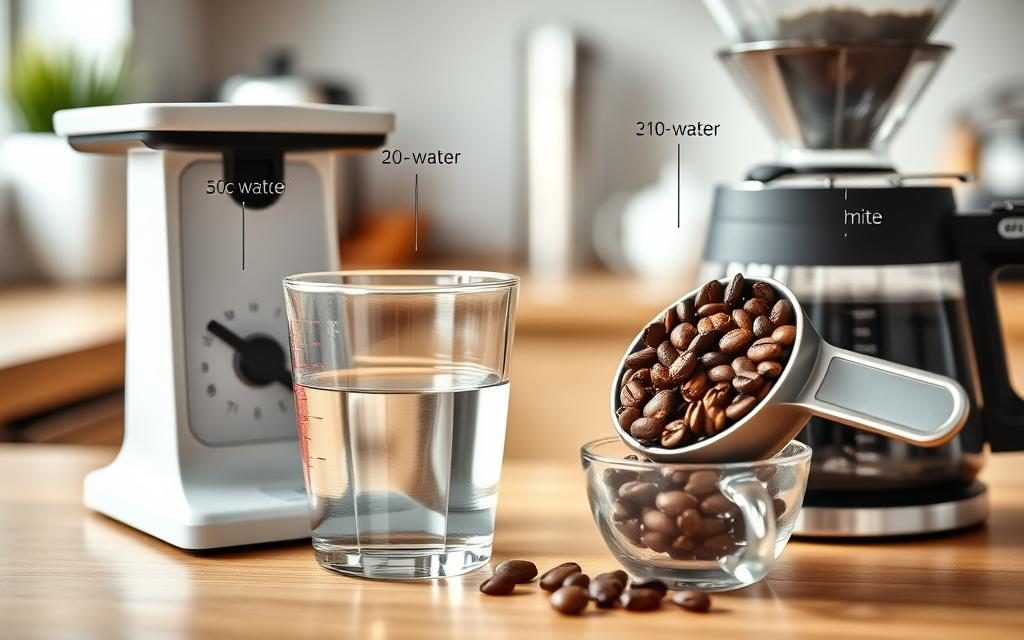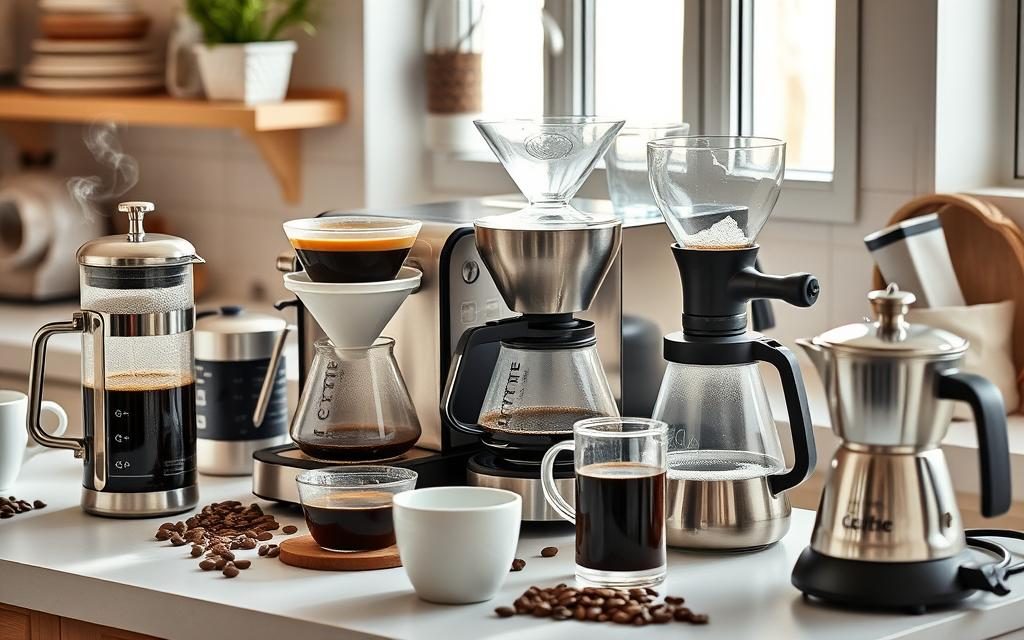
Ever wondered why your homemade coffee never tastes like the café masterpiece you crave? What if you could unlock the secrets to brewing the perfect cup right in your kitchen? Learning how to make coffee isn’t just a skill—it’s an art that transforms your morning routine.
Coffee brewing methods are more than just pouring hot water over grounds. The best way to make coffee requires precision, understanding, and a bit of passion. From selecting premium beans to mastering water temperature, each step contributes to creating those rich, aromatic homemade coffee recipes that wake up your senses.
Professional baristas know that great coffee isn’t about complexity—it’s about understanding fundamental techniques. Whether you’re a novice or a coffee enthusiast, these nine tips will elevate your brewing game and help you craft consistently delicious cups.
Key Takeaways
- Coffee brewing is a precise and personalized process
- Quality ingredients dramatically impact flavor
- Water temperature and brewing time are critical
- Different brewing methods require unique approaches
- Fresh beans and proper storage are essential
- Experimenting helps discover your perfect brew
- Clean equipment ensures great-tasting coffee
Choose the Right Coffee Beans
Choosing the right coffee beans is key for making coffee at home. The world of coffee beans is vast and exciting. It offers a journey for coffee lovers looking for the best tips.
Coffee beans are the heart of your brewing. Every year, 10 million tons of green coffee beans are made in 70 countries. Knowing about bean varieties can make your coffee-making journey fun.
Understanding Different Types of Beans
There are two main types of coffee beans:
- Arabica Beans: Known for smooth, sweet flavors with chocolate undertones
- Robusta Beans: Featuring a stronger, more bitter taste with higher caffeine content
The Impact of Roast Levels
| Roast Level | Flavor Profile | Recommended Use |
|---|---|---|
| Light Roast | Higher acidity, bright flavor | Pour-over, drip coffee |
| Medium Roast | Balanced flavor, moderate acidity | Versatile brewing methods |
| Dark Roast | Smoky, robust flavor | Espresso, French press |
Buying Fresh vs. Pre-Ground
For the best coffee, choose fresh beans. Coffee is most flavorful 7 to 21 days after roasting. Buy whole beans and grind them just before brewing for the best taste.
Pro tip for making coffee at home: Choose single-origin or special blends from trusted roasters. Make sure they show the roast date on their packaging.
The Importance of Water Quality
Water is key in making coffee. It makes up about 98% of your coffee. Good water quality can make your coffee taste better.

Filtering Options for Perfect Coffee Brewing
Choosing the right water filter is important. It can make your coffee taste better. Here are some options:
- Carbon filter pitchers
- Reverse Osmosis (RO) systems
- Mineral-enhancing water treatments
- Specialized coffee water filters
Temperature Matters in Coffee Brewing
Water temperature is very important. It should be between 90°C to 96°C (194°F to 205°F). If it’s too hot or cold, your coffee won’t taste right.
| Water Temperature | Brewing Impact |
|---|---|
| Below 90°C | Under-extraction, weak flavor |
| 90°C – 96°C | Perfect extraction, balanced flavor |
| Above 96°C | Over-extraction, bitter taste |
Mineral Content’s Flavor Influence
Minerals in water also matter. Magnesium makes coffee taste acidic. Calcium makes it sweet. Potassium balances the taste. Water with a pH of 6.5 to 7 is best.
- Soft water can result in weak, sour coffee
- Hard water might create bitter or metallic notes
- Balanced mineral content ensures the best extraction
Choosing Your Brewing Method
Coffee making is an art that starts with picking the right way to brew. Each method changes your coffee’s taste and style. It makes your homemade coffee special.
Every brewing method has its own charm. Knowing these can make your coffee go from good to great.
Drip Coffee Makers: Convenience and Consistency
Automatic drip coffee makers are loved by many. They offer:
- Consistent brewing temperature
- Easy making of many cups
- Simple morning routine
French Press vs. Pour-Over: Exploring Manual Brewing
Manual brewing lets you control your coffee. The French Press makes coffee rich and full. The Pour-Over gives a clean, nuanced taste.
| Brewing Method | Brew Time | Flavor Profile |
|---|---|---|
| French Press | 4 minutes | Bold, robust |
| Pour-Over | 2-3 minutes | Clean, bright |
Espresso Machines: Intense Flavor in Seconds
Espresso machines make strong coffee fast. They are great for making bold coffee shots. They are also key for many coffee drinks.
Choosing a brewing method depends on what you like, how much time you have, and what coffee experience you want. Try different ways to find your favorite coffee.
Coffee-to-Water Ratio Basics
Making the perfect coffee is an art. It starts with knowing the right coffee-to-water ratio. Both pros and home brewers know that exact measurements make a big difference.

The golden ratio for coffee isn’t the same for everyone. The method you use and what you like affect your coffee.
Finding Your Perfect Balance
Experts say to start with these ratios:
- 1:14 ratio for most brewing methods
- 7 grams of coffee per 100ml of water
- 55 grams of coffee per liter for specialty brewing
Measuring Tools to Use
Being precise is important for coffee. Pros say to use a digital scale for the best results.
| Brewing Method | Recommended Ratio | Measurement Tool |
|---|---|---|
| Drip Coffee | 1:16 | Digital Scale |
| French Press | 1:14 | Kitchen Scale |
| Espresso | 1:2 | Precision Scale |
Adjusting Ratios for Stronger Brews
If you want stronger coffee, try these:
- Increase coffee grounds by 10-15%
- Reduce water slightly
- Adjust grind size
Finding your perfect coffee ratio is a journey. Start with guidelines, then listen to your taste buds. They will guide you to a coffee that you love.
Grinding Coffee Beans Properly
Learning to grind coffee beans right is key for great coffee at home. The right grind makes a big difference. Every coffee guide says it’s important to know how to grind and choose the best method.
Types of Grinders: Blade vs. Burr
When you’re brewing coffee at home, picking the right grinder is important. There are two main types:
- Blade Grinders: They’re cheap but not very consistent
- Burr Grinders: They’re more precise and loved by coffee pros
Burr grinders make all the grounds the same size. This is key for getting the best flavor from your beans.
Ideal Grind Sizes for Different Brewing Methods
| Brewing Method | Grind Size | Brewing Time |
|---|---|---|
| Espresso | Fine | 20-30 seconds |
| Pour-Over | Medium | 2-3 minutes |
| French Press | Coarse | 4 minutes |
| Cold Brew | Extra Coarse | 12-24 hours |
When to Grind: Freshness Tips
Grinding your beans fresh is essential for great coffee. Here’s what experts say:
- Grind your beans right before you brew
- Use beans that are room temperature
- Keep the grounds in airtight containers
- Drink them within 2-4 weeks for the best taste
By focusing on grinding techniques, you’ll make your coffee at home better. You’ll get coffee that tastes amazing every time.
Best Brewing Techniques for Flavor
Mastering coffee brewing is an art. It turns simple coffee beans into a delightful experience. Whether you’re making strong coffee or trying light coffee techniques, knowing the brewing methods can make your daily cup better.

Brewing coffee is more than just pouring water over grounds. It’s a delicate process that needs precision and careful attention to detail. The right techniques can make your coffee recipe amazing.
Timing Your Brew Right
Extraction time is key for coffee flavor. Different methods need specific times to get the flavor right:
- Pour-over: 2-3 minutes
- French Press: 4 minutes
- Espresso: 25-30 seconds
- Cold Brew: 12-24 hours
Stirring and Blooming Explained
Coffee blooming is a key hack. It releases trapped gases and boosts flavor extraction. When hot water hits the coffee, it quickly releases CO2, helping flavors develop better.
| Brewing Method | Bloom Time | Water Temperature |
|---|---|---|
| Pour-Over | 30-45 seconds | 200-205°F |
| French Press | 30 seconds | 195-200°F |
| AeroPress | 20-30 seconds | 175-185°F |
Pouring Techniques for Even Extraction
Circular pouring makes water spread evenly. This stops channeling and helps flavor spread evenly. Start in the middle and move out in a gentle spiral.
Learning these brewing techniques can make your coffee routine amazing. You’ll get the most flavor from every bean.
Adding the Right Extras
Make your morning coffee special by adding the right things. It can turn a simple cup into a unique experience. Try different extras to make your coffee just right for you.
Exploring Milk and Cream Options
Choosing the right milk changes how your coffee tastes and feels. Here are some options:
- Whole milk: Creamy and rich
- Almond milk: Nutty and light
- Oat milk: Smooth and slightly sweet
- Coconut milk: Tropical undertones
Sweeteners: Choices Beyond Sugar
There’s more to sweetening your coffee than just sugar. Here are some other choices:
| Sweetener Type | Flavor Profile |
|---|---|
| Honey | Natural, floral sweetness |
| Maple Syrup | Rich, caramel-like notes |
| Agave Nectar | Mild, neutral sweetness |
| Stevia | Zero-calorie plant-based option |
Flavored Syrups and Spices
Spice up your coffee with exciting flavors. Try these creative additions:
- Cinnamon stick
- Vanilla extract
- Nutmeg powder
- Cardamom
- Cocoa nibs
Remember, each extra changes your coffee’s taste. Start small and adjust to find your favorite mix. The goal is to add to, not hide, your coffee’s natural taste.
Storing Coffee for Freshness
Keeping your coffee fresh is key. Knowing how to store your coffee beans is important. It makes brewing coffee easier and tastier.
Coffee lovers know storing it right is essential. The best place for coffee is between 50 and 70 degrees Fahrenheit. It should be away from moisture and light.
Best Practices for Sealing and Storing
- Use airtight containers made for coffee storage
- Choose containers that don’t let light in
- Keep coffee in a cool, dark place
- Don’t store it near heat or appliances
Understanding Coffee Shelf-Life
Fresh coffee beans don’t last long. Whole beans are best for about 90 days after roasting. Once you open a bag, it stays fresh for 10-14 days.
Avoiding Common Storage Mistakes
- Don’t put coffee beans in the fridge or freezer
- Don’t use clear containers
- Buy coffee in small amounts for freshness
- Check the roast date when you buy
For the best coffee, use special storage like the Fellow Atmos Vacuum Coffee Canister. It keeps air out and flavor in longer.
Remember, great coffee starts with caring for your beans. Storing them right means every cup is full of flavor and joy.
Troubleshooting Common Coffee Issues
Making the perfect cup of coffee at home can be tough. Even coffee lovers face problems that affect taste and quality. Knowing how to fix these issues can make your coffee better.
Decoding Brew Flavor Profiles
Coffee brewing can lead to different flavor problems. Here’s a guide to help you solve common coffee issues:
- Bitter Brew Solutions: Bitterness comes from coffee being in water too long or ground too fine.
- Sour Brew Corrections: Sour taste happens when water is too cool or coffee is too coarse.
Water and Grind Considerations
The coffee brewing guide points out important factors for good brew quality:
| Issue | Potential Cause | Recommended Solution |
|---|---|---|
| Weak Coffee | Not enough Coffee Grounds | Use more coffee (17:1 ratio is best) |
| Cloudy Coffee | Wrong Grind Size | Choose the right grind for your method |
| Oily Appearance | Too much extraction | Adjust brewing time and water heat |
Temperature and Extraction Tips
Baristas say to keep water at 195°F to 205°F for the best taste. A burr grinder makes grounds even, which is key for flavor. Also, gentle stirring while brewing helps.
- Use filtered water for the best taste
- Try different grind sizes
- Watch brewing time closely
Learning these coffee tips will help you fix brewing problems. This way, you’ll always have a great cup of coffee at home.
Enjoying Your Perfect Cup of Coffee
Making the perfect coffee is like art. It mixes science and what you like. Coffee lovers can make their brewing better by trying new things. It’s all about finding what you like best.
Getting good at coffee takes time. Start by trying different roasts and ways to brew. You’ll learn how small changes can make a big difference. Try coffee tasting with friends to share and learn.
Experimenting with New Recipes
Don’t be scared to try new things. Mix different beans, change the coffee-to-water ratio, or add unique flavors. Some people like adding cinnamon or trying different milks to make their coffee special.
Sharing Your Brew with Friends
Coffee is more than a drink—it’s a way to connect. Invite friends over for coffee, share your favorite ways to brew, and try new flavors together. Your love for coffee can inspire others to enjoy it too.
Cultivating a Coffee Routine
Make a special morning routine for coffee. Set time to grind beans, pick your brewing method, and enjoy every sip. Becoming a home barista is a fun journey of learning and enjoying.




